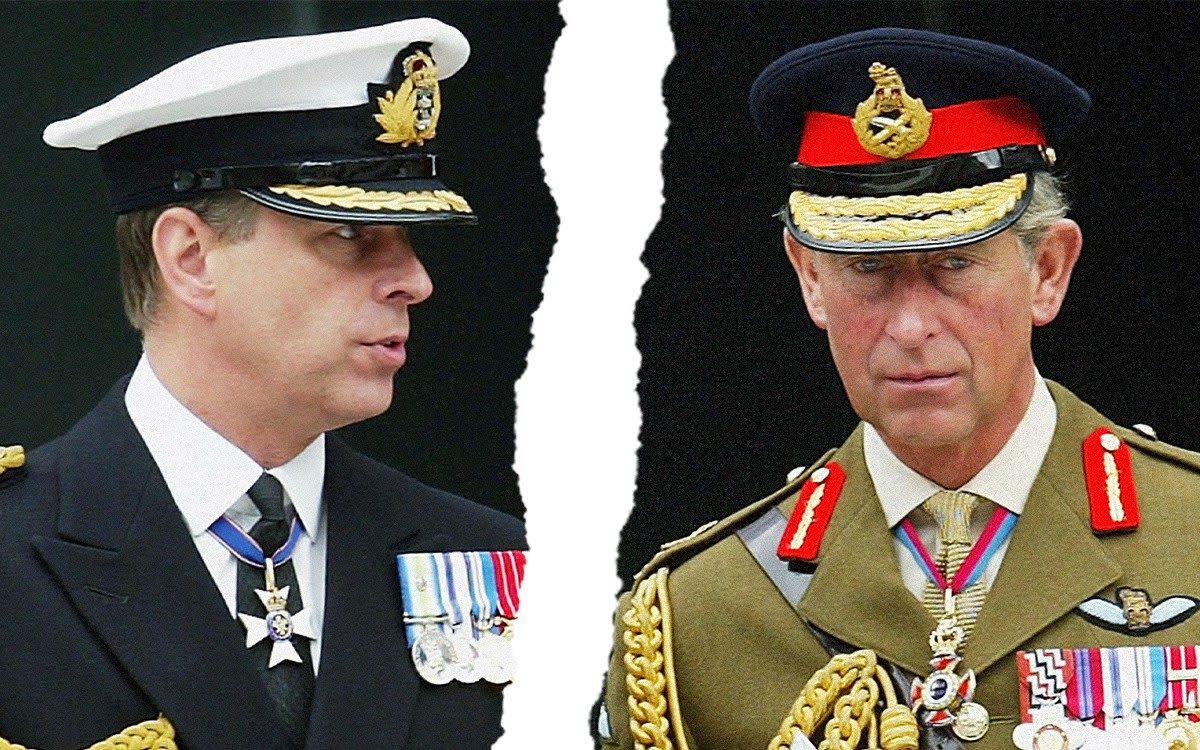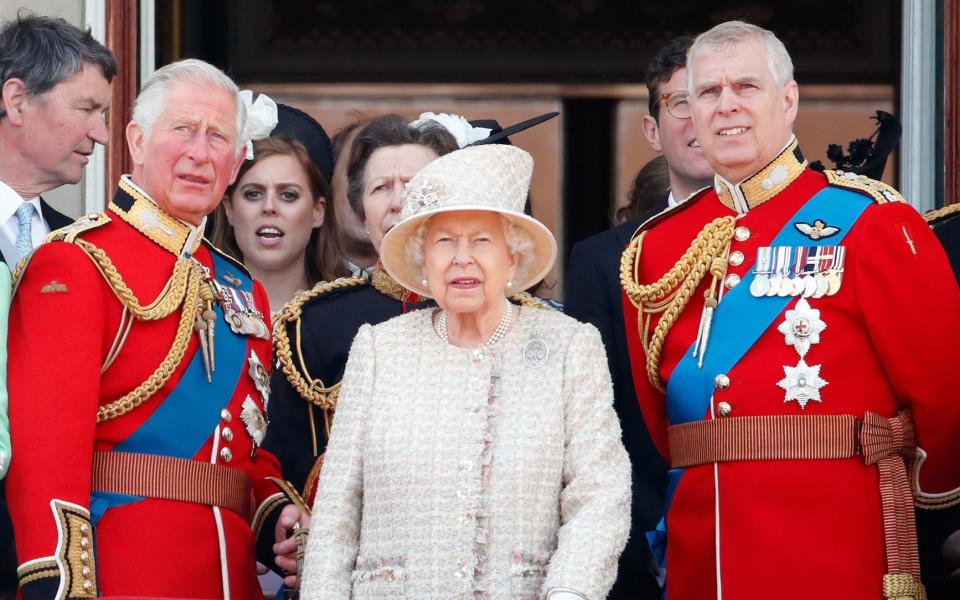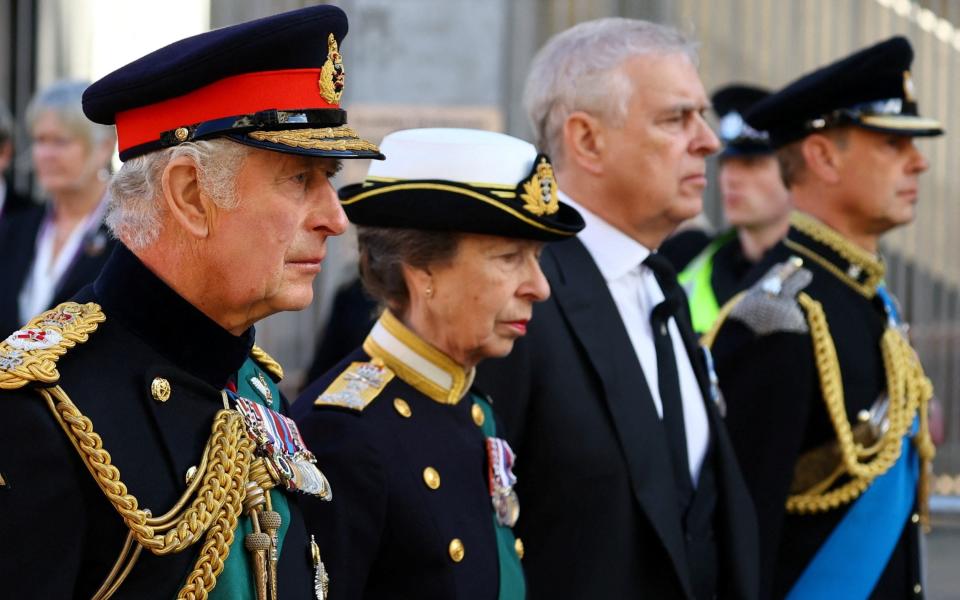How King Charles and Prince Andrew overcame their biggest fallout

Sibling rivalry has long been a feature of Royal life – with the ongoing row between the Prince of Wales and the Duke of Sussex just the latest in a long series of brotherly and sisterly spats dating back to the reign of Richard I.
Domestic relationships can be difficult to manage at the best of times, but when a family is also “a firm” with a hierarchy in the form of a line of succession – a degree of dysfunctionality seems inevitable.
Compared to the recent acrimony between William and Harry, however, the King’s relationships with his own siblings appear positively harmonious.
As Charles III prepares to be crowned on May 6, the 74-year-old monarch seems reassuringly close to his sister Princess Anne, 72, and younger brothers Prince Andrew, 63, and Prince Edward, 59.
The quartet spent Easter together, with Andrew’s ex-wife, Sarah, Duchess of York even invited to the private family celebrations at Windsor Castle (although she did not appear in public alongside her former in-laws at the traditional Easter Sunday service at St George’s Chapel.)
It came after “Fergie”, 63, was invited to spend Christmas at Sandringham House in Norfolk last year – the Royals’ first major family gathering following the death of Queen Elizabeth II on September 8.
Both invitations have been taken as evidence of the King’s attempts to bring his errant brother back in from the cold after he stepped down from public duties in November 2019 over his ill-judged relationship with convicted paedophile Jeffrey Epstein.
Although both Charles and William were instrumental in the late Queen’s decision to strip Andrew, her second, and some say, “favourite” son, of his remaining military titles and use of his His Royal Highness style in January 2022, suggestions that the accession would result in the Duke of York being further sidelined now appear wide of the mark.
According to one royal insider: “All four siblings spent most of the Easter weekend together with assorted children and plus ones – including the Duchess.
“There’s a warmth around the place and a proper rallying around the King, who in turn is showing some serious EQ (emotional intelligence) by ensuring the family is given the opportunity to pull together.”
Suggesting “some palace staff and parts of the media are well behind the curve in their understanding of this private family unity,” the source added: “The Duke stands four square behind the King.”
Blood thicker than water
Yet it hasn’t always been the case. In October 2016, Queen Elizabeth found herself at the centre of an extraordinary row within the Royal family over whether the Duke of York’s daughters should become full-time members of The Firm.
Andrew wrote to his mother demanding that Princesses Beatrice and Eugenie be given taxpayer-funded royal roles and new accommodation at Kensington Palace – but the move was blocked by Charles, then the Prince of Wales.
The letter, originally drafted by the Duke’s former private secretary and “gatekeeper” Amanda Thirsk before Andrew tore it up and rewrote it himself, complained that the princesses were in danger of being overshadowed by the then Duke and Duchess of Cambridge and Prince Harry when Charles became king.
It demanded that Beatrice and Eugenie, who are now ninth and eleventh in line to the throne, be given better accommodation at Kensington Palace instead of having to put up with “small” apartments at St James’s Palace.
The late Queen was apparently so stunned by the letter that she felt unable to reply and handed it to her private secretary Lord Geidt to deal with, who in turn raised the matter directly with Charles.
Intent on reigning over a “slimmed down” monarchy when the time came, he suggested that someone in government break it to his younger brother that his daughters would never play a formal role in the Royal family.
Little did any of them know at the time that the monarchy would be unexpectedly cut back by the departure of the Duke and Duchess of Sussex and Andrew’s own demise.

Yet if proof were ever needed that blood is thicker than water, less than a year later, the two warring brothers put their differences aside to oust Lord Geidt over a speech he gave in the ballroom of Buckingham Palace announcing Prince Philip’s retirement in May 2017.
Both Charles and Andrew believed the courtier had overstepped the mark by calling on all members of the Royal family and their households to pull together in support of the late Queen – and he left his post around four months later.
Lord Geidt had been at the centre of an earlier Royal family quarrel, during the Diamond Jubilee celebrations in 2012, when he supported the King’s plan to scale down the royals’ appearance on the Buckingham Palace balcony.
On previous occasions, this would have involved extended family – but as the flypast soared overhead, it was just the late Queen, Prince Charles and the Duchess of Cornwall, as they were then known, William, Kate and Harry (Philip was absent with a bladder infection).
For Andrew, the sudden and unexpected demotion was “like a dagger to his heart”, according to a source quoted in Valentine Low’s 2022 book Courtiers.
“Prince Edward was also said to be dismayed by Charles’s behaviour,” added the book. “Princess Anne, on the other hand, ‘couldn’t give a stuff’, according to another source.”
Surface tensions
The incident marked the first sense of unease over the transition from the Elizabethan to Caroleon era. Yet a lot has changed since then. The births of William’s children Prince George, nine, Princess Charlotte, seven, and Prince Louis, five – and Harry’s children Prince Archie, nearly four, and Princess Lilibet, nearly two, has arguably helped to acclimatise the older generation to having to take more of a back seat.
Then when “Megxit” happened, the King’s siblings rallied around him in the face of the repeated attacks by the Sussexes.
Naturally, the deterioration in Queen Elizabeth’s health in the last year of her life also brought the family together. Anne was with her late mother at Balmoral Castle when she took a turn for the worse on the morning of her death and urgently summoned Charles from Dumfries House. An RAF plane carrying William, Andrew, Edward and Sophie sadly landed too late for them to say their final goodbyes.
Yet the separation of the two pairs of siblings spoke to how they grew up – Charles and Anne much closer in age, with Andrew born a decade later followed by Edward, the so-called “baby” of the family.

Such is the age gap that Charles had finished Gordonstoun before Edward, 16 years his junior, was even out of nappies.
Although much shier and less confrontational than Andrew, Edward has also had the odd run in with the King over the years – not least when his production company Ardent was caught filming at William’s university, St Andrew’s, despite an undertaking with the press to protect his privacy.
Although Edward had not known about the filming and instructed the crew to stop as soon as he became aware of the situation, he was forced to apologise to his brother’s private secretary over the incident.
Tensions also rose to the surface more recently when it was suggested that Charles initially planned to block a move to make Edward the next Duke of Edinburgh.
When he married Sophie Rhys-Jones in 1999, Buckingham Palace announced that although they would be known as the Earl and Countess of Wessex, “The Queen, the Duke of Edinburgh and the Prince of Wales have also agreed that the Prince Edward should be given the Dukedom of Edinburgh in due course, when the present title held now by Prince Philip eventually reverts to the Crown.”
Following the deaths of their parents, however, reports emerged that the King was minded not to give the title to the Wessexes.
It later transpired that there were concerns that such an important dukedom, in the context of the union, should go to a royal so far down the pecking order. (When Philip expressed his wish for Edward to inherit his title, he was seventh in line to the throne – now he’s 13th.)
As such, a compromise was reached that will see Edward hold the title for his lifetime only, before it is returned to the Crown to be conferred on a more senior royal, possibly Princess Charlotte.
(Titles have never been an issue for Anne because she rejected them for her own children Peter Phillips and Zara Tindall – which perhaps goes some way to explaining why she and Charles have always got along well. Despite her reported initial reluctance to curtsy to Camilla after she officially became her sister in law in 2005, they share a love of horses and will forever be bonded by the fact that Camilla’s first husband Andrew Parker Bowles, who is coming to the Coronation, was once Anne’s boyfriend and remains a close confidante.)
The agreement with Edward is not just a reflection of brotherly love, though.
It also highlights the compromises a sovereign has to make with their “spares” when reigning over what is very much a family business.


